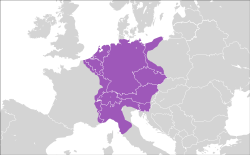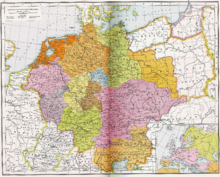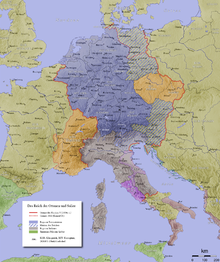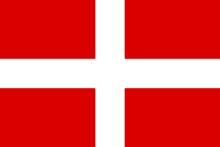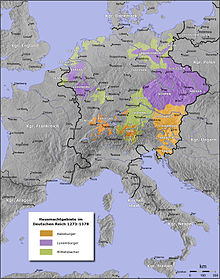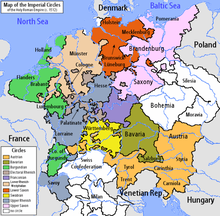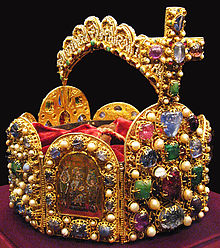- Holy Roman Empire
-
The Holy Roman Empire (HRE; German: Heiliges Römisches Reich (HRR), Latin: Imperium Romanum Sacrum (IRS), Italian: Sacro Romano Impero (SRI)) was a realm (Reich) that existed from 962 to 1806 in Central Europe. It was ruled by the Holy Roman Emperor. Its character changed during the Middle Ages and the Early Modern period, when the power of the emperor gradually weakened in favour of the princes. In its last centuries, its character became quite close to a union of territories.
The empire's territory was centered on the Kingdom of Germany, and included neighbouring territories, which at its peak included the Kingdom of Italy and the Kingdom of Burgundy. For much of its history, the Empire consisted of hundreds of smaller sub-units, principalities, duchies, counties, Free Imperial Cities and other domains.
Otto I was crowned King of Germany in 962, but he is nevertheless considered to have been the first Holy Roman Emperor (German: Römisch-Deutscher Kaiser) in retrospect. Otto was the first emperor of the realm who was not a member of the earlier Carolingian dynasty.[2] The last Holy Roman Emperor was Francis II, who abdicated and dissolved the Empire in 1806 during the Napoleonic Wars. In a decree following the 1512 Diet of Cologne, the name was officially changed to Holy Roman Empire of the German Nation (German: Heiliges Römisches Reich Deutscher Nation, Latin: Imperium Romanum Sacrum Nationis Germanicæ).[3]
The territories and dominion of the Holy Roman Empire in terms of present-day states comprised Germany (except Southern Schleswig), Austria (except Burgenland), the Czech Republic, Switzerland and Liechtenstein, the Netherlands, Belgium, Luxembourg and Slovenia (except Prekmurje), besides significant parts of eastern France (mainly Artois, Alsace, Franche-Comté, French Flanders, Savoy and Lorraine), northern Italy (mainly Lombardy, Piedmont, Emilia-Romagna, Tuscany, Trentino and South Tyrol), and western Poland (mainly Silesia, Pomerania and Neumark).
Contents
Name
The term sacrum (i.e. "holy") in connection with the medieval Roman Empire was used from 1157, under Frederick I Barbarossa.[4] Before 1157, the realm was merely referred to as the Roman Empire.[3]
In a decree following the 1512 Diet of Cologne, the name was officially changed to Holy Roman Empire of the German Nation (German: Heiliges Römisches Reich Deutscher Nation, Latin: Imperium Romanum Sacrum Nationis Germanicæ).[5]
The Holy Roman Empire was named after the Roman Empire and was considered its continuation. This is based in the medieval concept of translatio imperii and does not mean that the Empire's territory included the city of Rome, any more than did that of the Eastern Roman Empire (Βασιλεία Ῥωμαίων), which retook and lost the city in the 600s CE under the successful general Belisarius.
The French Enlightenment writer Voltaire remarked sardonically that "this agglomeration which was called and which still calls itself the Holy Roman Empire was neither holy, nor Roman, nor an empire."[6]
History
Carolingian forerunners
Further information: Carolingian EmpireThe Holy Roman Empire looked to Charlemagne, King of the Franks, as its founder, who had been crowned Emperor of the Romans in 800 by Pope Leo III.[7][8] The Western Roman Empire was thus revived (Latin: renovatio Romanorum imperii) by transferring it to the Frankish king. This translatio imperii remained the basis for the Holy Roman Empire, at least in theory, until its demise in 1806.
The Carolingian imperial crown was initially disputed among the Carolingian rulers of Western Francia (France) and Eastern Francia (Germany), with first the western king (Charles the Bald) and then the eastern (Charles the Fat) attaining the prize. However, after the death of Charles the Fat in 888 the Carolingian Empire broke asunder, never to be restored. According to Regino of Prüm, each part of the realm elected a "kinglet" from its own "bowels." After the death of Charles the Fat those crowned Emperor by the Pope controlled only territories in Italy. The last such Emperor was Berengar I of Italy who died in 924.
High Middle Ages
Further information: Kingdom of GermanyFormation
Around 900, East Francia saw the reemergence of autonomous stem duchies (Franconia, Bavaria, Alemannia and Saxony). After the Carolingian king Louis the Child died without issue in 911, East Francia did not turn to the Carolingian ruler of West Francia to take over the realm but elected one of the dukes, Conrad of Franconia, as Rex Francorum Orientalum. On his deathbed, Conrad yielded the crown to his main rival, Henry of Saxony (r. 919–36), who was elected king at the Diet of Fritzlar in 919. Henry reached a truce with the raiding Magyars and in 933 won a first victory against them in the Battle of Riade.
Henry died in 936 but his family, the Liudolfing (or Ottonian) dynasty, would continue to rule the Eastern kingdom for roughly a century. Henry's designated successor, Otto, was elected King in Aachen in 936. He overcame a series of revolts—both from an elder brother and from several dukes. After that, the king managed to control the appointment of dukes and often also employed bishops in administrative affairs.
The Kingdom had no permanent capital city and the kings travelled from residence to residence (called Kaiserpfalz) to discharge affairs. However, each king preferred certain places, in Otto's case, the city of Magdeburg. Kingship continued to be transferred by election, but Kings often had their sons elected during their lifetime, enabling them to keep the crown for their families. This only changed after the end of the Salian dynasty in the 12th century.
In 955, Otto won a decisive victory over the Magyars in the Battle of Lechfeld. In 951, Otto came to the aid of Adelaide, the widowed queen of Italy, defeating her enemies. He then married her and took control over Italy. In 962, Otto was crowned Emperor by the Pope. From then on, the affairs of the German kingdom were intertwined with that of Italy and the Papacy. Otto's coronation as Emperor made the German kings successors to the Empire of Charlemagne, which through translatio imperii also made them successors to Ancient Rome.
This also renewed the conflict with the Eastern Emperor in Constantinople, especially after Otto's son Otto II (r. 967–83) adopted the designation imperator Romanorum. Still, Otto formed marital ties with the east, when he married the Byzantine princess Theophanu. Their son, Otto III, focused his attention on Italy and Rome and employed widespread diplomacy but died young in 1002, to be succeeded by his cousin Henry II, who focused on Germany.
When Henry II died in 1024, Conrad II, first of the Salian Dynasty, was then elected king in 1024 only after some debate among dukes and nobles, which would eventually develop into the collegiate of Electors.
Investiture Controversy
Kings often employed bishops in administrative affairs and often determined who would be appointed to ecclesiastical offices. In the wake of the Cluniac Reforms, this involvement was increasingly seen as inappropriate by the Papacy. The reform-minded Pope Gregory VII was determined to oppose such practices, leading to the Investiture Controversy with King Henry IV (r. 1056–1106), who repudiated the Pope's interference and persuaded his bishops to excommunicate the Pope, whom he famously addressed as "Hildebrand... Not Pope but false monk!" The Pope, in turn, excommunicated the king, declared him deposed and dissolved the oaths of loyalty made to Henry. The king found himself with almost no political support and was forced to make the famous Walk to Canossa in 1077, by which he achieved a lifting of the excommunication at the price of humiliation. Meanwhile, the German princes had elected another king, Rudolf of Swabia. Henry managed to defeat him but was subsequently confronted with more uprisings, renewed excommunication and even the rebellion of his sons. It was his second son, Henry V, who managed to reach an agreement with both the Pope and the bishops in the 1122 Concordat of Worms. The political power of the Empire was maintained but the conflict had demonstrated the limits of any ruler's power, especially in regard to the Church, and robbed the king of the sacral status he had previously enjoyed. Both the Pope and the German princes had surfaced as major players in the political system of the Empire.
Hohenstaufen dynasty
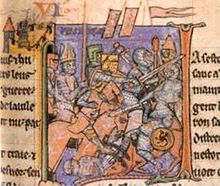 Adhemar de Monteil carries the Holy Lance.
Adhemar de Monteil carries the Holy Lance.
When the Salian dynasty ended with Henry V's death in 1125, the princes chose not to elect the next of kin, but rather Lothair, the moderately powerful but already old Duke of Saxony. When he died in 1138, the princes again aimed at checking royal power; accordingly they did not elect Lothair's favoured heir, his son-in-law Henry the Proud of the Welf family, but Conrad III of the Hohenstaufen family, close relatives of the Salians, leading to over a century of strife between the two houses. Conrad ousted the Welfs from the possessions, but after his death in 1152, his nephew Frederick I "Barbarossa" succeeded and made peace with the Welfs, restoring his cousin Henry the Lion to his — albeit diminished — possessions.
The Hohenstaufen rulers increasingly lent land to ministerialia, formerly non-free service men, which Frederick hoped would be more reliable than dukes. Initially used mainly for war services, this new class of people would form the basis for the later knights, another basis of imperial power. Another important constitutional move at Roncaglia was the establishment of a new peace (Landfrieden) for all of the Empire, an attempt to (on the one hand) abolish private feuds not only between the many dukes, but on the other hand a means to tie the Emperor's subordinates to a legal system of jurisdiction and public prosecution of criminal acts — a predecessor of the modern concept of "rule of law". Another new concept of the time was the systematic foundation of new cities, both by the Emperor and the local dukes. These were partly caused by the explosion in population, but also to concentrate economic power at strategic locations, while formerly cities only existed in the shape of either old Roman foundations or older bishoprics. Cities that were founded in the 12th century include Freiburg, possibly the economic model for many later cities, and Munich.
Frederick was crowned Emperor in 1155 and emphasised the Empire's "Romanness", partly in an attempt to justify the Emperor's power independently of the (now strengthened) Pope. An imperial assembly at the fields of Roncaglia in 1158 reclaimed imperial rights in reference to Justinian's Corpus Juris Civilis. Imperial rights had been referred to as regalia since the Investiture Controversy, but were enumerated for the first time at Roncaglia as well. This comprehensive list included public roads, tariffs, coining, collecting punitive fees and the investiture, the seating and unseating of office holders. These rights were now explicitly rooted in Roman Law, a far-reaching constitutional act.
Frederick's policies were mainly aimed at Italy, where he clashed with the increasingly wealthy and free-minded cities of the north, especially Milan. He also embroiled himself in another conflict with the Papacy by supporting a candidate elected by a minority against Pope Alexander III (1159–81). Frederick supported a succession of antipopes before finally making peace with Alexander in 1177. In Germany, the Emperor had repeatedly protected Henry the Lion against complaints by rival princes or cities (especially in the cases of Munich and Lübeck). Henry's support of Frederick's policies was only lackluster and in a critical situation during the Italian wars, Henry refused the Emperor's plea for military support. After his return to Germany, an embittered Frederick opened proceedings against the Duke, resulting in a public ban and the confiscation of all territories.
During the Hohenstaufen period, German princes facilitated a successful, peaceful eastward settlement of lands previously sparsely inhabited by West Slavs or uninhabited, by German speaking farmers, traders and craftsmen from the western part of the Empire, both Christians and Jews. The gradual germanization of these lands was a complex phenomenon which should not be interpreted in terms of 19th century nationalism's bias. By the eastward settlement the Empire's influence increased to eventually include Pomerania and Silesia – also due to intermarriage of the local, still mostly Slavic, rulers with German spouses. Also, the Teutonic Knights were invited to Prussia by Duke Konrad of Masovia to Christianise the Prussians in 1226. The monastic state of the Teutonic Order (German: Deutschordensstaat) and its later German successor states of Prussia however never were part of the Holy Roman Empire.
In 1190, Barbarossa participated in the Third Crusade and died in Asia Minor. Under his son and successor, Henry VI, the Hohenstaufen dynasty reached its apex. Henry added the Norman kingdom of Sicily to his domains, held English king Richard Lionheart captive and aimed to establishing a hereditary monarchy, when he died in 1197. As his son, Frederick II, though already elected king, was still a small child and living in Sicily, German princes chose to elect an adult king, which resulted in the dual election of Barbarossa's youngest son Philip of Swabia and Henry the Lion's son Otto of Brunswick, who competed for the crown. Otto prevailed for a while after Philip was murdered in a private squabble in 1208 until he began to also claim Sicily. Pope Innocent III, who feared the threat posed by a union of the Empire and Sicily, now supported Sicily's king Frederick II, who marched to Germany and defeated Otto. After his victory, Frederick did not act upon his promise to keep the two realms separate - though he had made his son Henry king of Sicily before marching on Germany, he still reserved real political power for himself. This continued after Frederick was crowned Emperor in 1220. Fearing Frederick's concentration of power, the Pope finally excommunicated the Emperor. Another point was the crusade, which Frederick had promised but repeatedly postponed. Now, though excommunicated, Frederick led the crusade in 1228, which however ended in negotiations and a temporary restoration of the Kingdom of Jerusalem. The conflict with the Pope endured who later supported the election of an anti-king in Germany.
Despite his imperial claims, Frederick's rule was a major turning point towards the disintegration of a central rule in the Empire. While concentrated on establishing a modern, centralised state in Sicily, he was mostly absent from Germany and issued far-reaching privileges to Germany's secular and ecclesiastical princes: In the 1220 Confoederatio cum principibus ecclesiasticis, Frederick gave up a number of regalia in favour of the bishops, among them tariffs, coining, and fortification. The 1232 Statutum in favorem principum mostly extended these privileges to secular territories. Although many of these privileges had existed earlier, they were now granted globally, and once and for all, to allow the German princes to maintain order north of the Alps while Frederick wanted to concentrate on Italy. The 1232 document marked the first time that the German dukes were called domini terræ, owners of their lands, a remarkable change in terminology as well.
Interregnum
After the death of Frederick II in 1250, the German kingdom was divided among his son Conrad IV (died 1254) and the anti-king, William of Holland (died 1256). Conrad's death was followed by the Interregnum, during which no king could achieve universal recognition and the princes managed to consolidate their holdings and became even more independent rulers. After 1257, the crown was contested between Richard of Cornwall, who was supported by the Guelph party, and Alfonso X of Castile, who was recognised by the Hohenstaufen party but never set foot on German soil. After Richard's death in 1273, the Interregnum ended with unanimous election of Rudolph I of Habsburg, a minor pro-Staufen count.
Changes in political structure
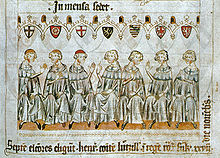 The Prince-electors
The Prince-electors
The 13th century also saw a general structural change in how land was administered, preparing the shift of political power towards the rising bourgeoisie at the expense of aristocratic feudalism that would characterize the Late Middle Ages.
Instead of personal duties, money increasingly became the common means to represent economic value in agriculture. Peasants were increasingly required to pay tribute for their lands. The concept of "property" began to replace more ancient forms of jurisdiction, although they were still very much tied together. In the territories (not at the level of the Empire), power became increasingly bundled: Whoever owned the land had jurisdiction, from which other powers derived. It is important to note, however, that jurisdiction at this time did not include legislation, which virtually did not exist until well into the 15th century. Court practice heavily relied on traditional customs or rules described as customary.
It is during this time that the territories began to transform themselves into predecessors of modern states. The process varied greatly among the various lands and was most advanced in those territories that were most identical to the lands of the old Germanic tribes, e.g. Bavaria. It was slower in those scattered territories that were founded through imperial privileges.
Late Middle Ages
Further information: Late Middle Ages and Pomerania during the Late Middle AgesRise of the territories after the Hohenstaufen
The difficulties in electing the king eventually led to the emergence of a fixed college of Prince-electors (Kurfürsten), whose composition and procedures were set forth in the Golden Bull of 1356. This development probably best symbolises the emerging duality between emperor and realm (Kaiser und Reich), which were no longer considered identical. This is also revealed in the way the post-Hohenstaufen kings attempted to sustain their power. Earlier, the Empire's strength (and finances) greatly relied on the Empire's own lands, the so-called Reichsgut, which always belonged to the king of the day and included many Imperial Cities. After the 13th century, the relevance of the Reichsgut faded, even though some parts of it did remain until the Empire's end in 1806. Instead, the Reichsgut was increasingly pawned to local dukes, sometimes to raise money for the Empire, but more frequently to reward faithful duty or as an attempt to establish control over the dukes. The direct governance of the Reichsgut no longer matched the needs of either the king or the dukes.
Instead, the kings, beginning with Rudolph I of Habsburg, increasingly relied on the lands of their respective dynasties to support their power. In contrast with the Reichsgut, which was mostly scattered and difficult to administer, these territories were relatively compact and thus easier to control. In 1282, Rudolph I thus lent Austria and Styria to his own sons.
With Henry VII, the House of Luxembourg entered the stage. In 1312, Henry was crowned as the first Holy Roman Emperor since Frederick II. After him all kings and emperors relied on the lands of their own family (Hausmacht): Louis IV of Wittelsbach (king 1314, emperor 1328–47) relied on his lands in Bavaria; Charles IV of Luxembourg, the grandson of Henry VII, drew strength from his own lands in Bohemia. Interestingly, it was thus increasingly in the king's own interest to strengthen the power of the territories, since the king profited from such a benefit in his own lands as well.
Imperial reform
Further information: Vehmic courtThe "constitution" of the Empire was still largely unsettled at the beginning of the 15th century. Although some procedures and institutions had been fixed, for example by the Golden Bull of 1356, the rules of how the king, the electors, and the other dukes should cooperate in the Empire much depended on the personality of the respective king. It therefore proved somewhat damaging that Sigismund of Luxemburg (king 1410, emperor 1433–37) and Frederick III of Habsburg (king 1440, emperor 1452–93) neglected the old core lands of the empire and mostly resided in their own lands. Without the presence of the king, the old institution of the Hoftag, the assembly of the realm's leading men, deteriorated. The Imperial Diet as a legislative organ of the Empire did not exist at that time. Even worse, dukes often went into feuds against each other that, more often than not, escalated into local wars.
Simultaneously, the Church was in a state of crisis too, with wide-reaching effects in the Empire. The conflict between several papal claimants (two anti-popes and the legitimate Pope) was only resolved at the Council of Constance (1414–18); after 1419, much energy was spent on fighting the Hussites. The medieval idea of unifying all Christendom into a single political entity, of which the Church and the Empire were the leading institutions, began to decline.
With these drastic changes, much discussion emerged in the 15th century about the Empire itself. Rules from the past no longer adequately described the structure of the time, and a reinforcement of earlier Landfrieden was urgently called for. During this time, the concept of "reform" emerged, in the original sense of the Latin verb re-formare, to regain an earlier shape that had been lost.
When Frederick III needed the dukes to finance war against Hungary in 1486 and at the same time had his son, later Maximilian I elected king, he was presented with the dukes' united demand to participate in an Imperial Court. For the first time, the assembly of the electors and other dukes was now called the Imperial Diet (German Reichstag) (to be joined by the Imperial Free Cities later). While Frederick refused, his more conciliatory son finally convened the Diet at Worms in 1495, after his father's death in 1493. Here, the king and the dukes agreed on four bills, commonly referred to as the Reichsreform (Imperial Reform): a set of legal acts to give the disintegrating Empire back some structure. Among others, this act produced the Imperial Circle Estates and the Reichskammergericht (Imperial Chamber Court); structures that would—to a degree—persist until the end of the Empire in 1806.
However, it took a few more decades until the new regulation was universally accepted and the new court actually began to function; only in 1512 would the Imperial Circles be finalised. The King also made sure that his own court, the Reichshofrat, continued to function in parallel to the Reichskammergericht. In this year, the Empire also received its new title, the Heiliges Römisches Reich Deutscher Nation ("Holy Roman Empire of the German Nation").
Reformation and Renaissance
Further information: German Reformation and German RenaissanceSee also: Charles V, Holy Roman EmperorIn 1516, Ferdinand II of Aragon, grandfather of the future Holy Roman Emperor Charles V, died. Due to a combination of (1) the traditions of dynastic succession in Aragon, which permitted maternal inheritance with no precedence for female rule; (2) the insanity of Charles's mother, Joanna of Castile; and (3) the insistence by his remaining grandfather, Maximilian I, that he take up his royal titles, Charles initiated his reign in Castile and Aragon, a union which evolved into Spain, in conjunction with his mother. This ensured for the first time that all the realms of the Iberian peninsula (save for Portugal) would be united by one monarch under one nascent Spanish crown, with the founding territories retaining their separate governance codes and laws. In 1519, already reigning as Carlos I in Spain, Charles took up the imperial title as Karl V. The balance (and imbalance) between these separate inheritances would be defining elements of his reign, and would ensure that personal union between the Spanish and German crowns would be short-lived. The latter would end up going to a more junior branch of the Habsburgs in the person of Charles's brother Ferdinand, while the senior branch continued rule in Spain and in the Burgundian inheritance in the person of Charles's son, Philip II of Spain.
In addition to conflicts between his Spanish and German inheritances, conflicts of religion would be another source of tension during the reign of Charles V. Before Charles even began his reign in the Holy Roman Empire, in 1517, Martin Luther initiated what would later be known as the Reformation. At this time, many local dukes saw it as a chance to oppose the hegemony of Emperor Charles V. The empire then became fatally divided along religious lines, with the north, the east, and many of the major cities—Strasbourg, Frankfurt and Nuremberg—becoming Protestant while the southern and western regions largely remained Catholic.
From 1515 to 1523, the Habsburg government in the Netherlands also had to contend with the Frisian peasant rebellion, led first by Pier Gerlofs Donia and then by his nephew Wijerd Jelckama. The rebels were initially successful, but after a series of defeats, the remaining leaders were taken and decapitated in 1523. This was a blow for the Holy Roman Empire since many major cities were sacked and as many as 132 ships sunk (once even 28 in a single battle).
Baroque period
Main articles: Early Modern history of Germany and Pomerania during the Early Modern AgeFurther information: Baroque period, Protestant Union, Catholic League (German), and Thirty Years WarCharles V continued to battle the French and the Protestant princes in Germany for much of his reign. After his son Philip married Queen Mary of England, it appeared that France would be completely surrounded by Habsburg domains, but this hope proved unfounded when the marriage produced no children. In 1555, Paul IV was elected pope and took the side of France, whereupon an exhausted Charles finally gave up his hopes of a world Christian empire. He abdicated and divided his territories between Philip and Ferdinand of Austria. The Peace of Augsburg ended the war in Germany and accepted the existence of the Protestant princes, although not Calvinism, Anabaptism, or Zwingliism.
Germany would enjoy relative peace for the next six decades. On the eastern front, the Turks continued to loom large as a threat, although war would mean further compromises with the Protestant princes, and so the Emperor sought to avoid that. In the west, the Rhineland increasingly fell under French influence. After the Dutch revolt against Spain erupted, the Empire remained neutral. A side effect was the Cologne War, which ravaged much of the upper Rhine.
After Ferdinand died in 1564, his son Maximilian II became Emperor, and like his father, accepted the existence of Protestantism and the need for occasional compromise with it. Maximilian was succeeded in 1576 by Rudolf II, a strange man who preferred classical Greek philosophy to Christianity and lived an isolated existence in Bohemia. He became afraid to act when the Catholic Church was forcibly reasserting control in Austria and Hungary and the Protestant princes became upset over this. Imperial power sharply deteriorated by the time of Rudolf's death in 1612. When Bohemians rebelled against the Emperor, the immediate result was the series of conflicts known as the Thirty Years' War (1618–48), which devastated the Empire. Foreign powers, including France and Sweden, intervened in the conflict and strengthened those fighting Imperial power, but also seized considerable territory for themselves. The long conflict so bled the Empire that it never recovered its strength.
At the Battle of Vienna (1683), the Army of the Holy Roman Empire, led by the Polish King John III Sobieski, decisively defeated a large Turkish army, ending the western colonial Ottoman advance and leading to the eventual dismemberment of the Ottoman Empire in Europe. The HRE army was half Polish/Lithuanian Commonwealth forces, mostly cavalry, and half Holy Roman Empire forces (German/Austrian), mostly infantry. The cavalry charge was the largest in the history of warfare.
 The Empire after the Peace of Westphalia, 1648
The Empire after the Peace of Westphalia, 1648
 Map of the Holy Roman Empire in 1789. The map is dominated by the Habsburg Monarchy (brown) and the Kingdom of Prussia (blue), besides a large number of small states (many of them too small to be shown on map)
Map of the Holy Roman Empire in 1789. The map is dominated by the Habsburg Monarchy (brown) and the Kingdom of Prussia (blue), besides a large number of small states (many of them too small to be shown on map)
The actual end of the empire came in several steps. The Peace of Westphalia in 1648, which ended the Thirty Years' War, gave the territories almost complete sovereignty. The Swiss Confederation, which had already established quasi-independence in 1499, as well as the Northern Netherlands, left the Empire. Although its constituent states still had some restrictions—in particular, they could not form alliances against the Emperor — the Empire from this point was a powerless entity, existing in name only. The Habsburg Emperors instead focused on consolidating their own estates in Austria and elsewhere.
Modern period
Main article: 18th century history of GermanyPrussia and Austria
By the rise of Louis XIV, the Habsburgs were dependent on the position as Archdukes of Austria to counter the rise of Prussia, some of whose territories lay inside the Empire. Throughout the 18th century, the Habsburgs were embroiled in various European conflicts, such as the War of the Spanish Succession, the War of the Polish Succession and the War of the Austrian Succession. The German dualism between Austria and Prussia dominated the empire's history after 1740.
French Revolutionary Wars and final dissolution
Further information: 19th century history of GermanyFrom 1792 onwards, revolutionary France was at war with various parts of the Empire intermittently. The German Mediatisation was the series of mediatisations and secularisations that occurred in 1795–1814, during the latter part of the era of the French Revolution and then the Napoleonic Era.
Mediatisation was the process of annexing the lands of one sovereign monarchy to another, often leaving the annexed some rights. Secularisation was the redistribution to secular states of the secular lands held by an ecclesiastical ruler such as a bishop or an abbot.
The Empire was formally dissolved on 6 August 1806 when the last Holy Roman Emperor Francis II (from 1804, Emperor Francis I of Austria) abdicated, following a military defeat by the French under Napoleon (see Treaty of Pressburg). Napoleon reorganized much of the Empire into the Confederation of the Rhine, a French satellite. Francis' House of Habsburg-Lorraine survived the demise of the Empire, continuing to reign as Emperors of Austria and Kings of Hungary until the Habsburg empire's final dissolution in 1918 in the aftermath of World War I.
The Napoleonic Confederation of the Rhine was replaced by a new union, the German Confederation, in 1815, following the end of the Napoleonic Wars. It lasted until 1866 when Prussia founded the North German Confederation, a forerunner of the German Empire which united the German-speaking territories outside of Austria and Switzerland under Prussian leadership in 1871. This later served as the predecessor-state of modern Germany.
Institutions
The Holy Roman Empire was not a highly centralized state like most countries today. Instead, it was divided into dozens—eventually hundreds—of individual entities governed by kings,[9] dukes, counts, bishops, abbots or other rulers, collectively known as princes. There were also some areas ruled directly by the Emperor. At no time could the Emperor simply issue decrees and govern autonomously over the Empire. His power was severely restricted by the various local leaders.
From the High Middle Ages onwards, the Holy Roman Empire was marked by an uneasy coexistence of the princes of the local territories who were struggling to take power away from it. To a greater extent than in other medieval kingdoms such as France and England, the Emperors were unable to gain much control over the lands that they formally owned. Instead, to secure their own position from the threat of being deposed, Emperors were forced to grant more and more autonomy to local rulers, both nobles and bishops. This process began in the 11th century with the Investiture Controversy and was more or less concluded with the 1648 Peace of Westphalia. Several Emperors attempted to reverse this steady dissemination of their authority, but were thwarted both by the papacy and by the princes of the Empire.
Imperial estates
Main article: Imperial StateThe number of territories in the Empire was considerable, rising to approximately 300 at the time of the Peace of Westphalia. Many of these Kleinstaaten ("little states") covered no more than a few square miles, or included several non-contiguous pieces, so the Empire was often called a Flickenteppich ("patchwork carpet").
An entity was considered a Reichsstand (imperial estate) if, according to feudal law, it had no authority above it except the Holy Roman Emperor himself. The imperial estates comprised:
- Territories ruled by a hereditary nobleman, such as a prince, archduke, duke, or count.
- Territories in which secular authority was held by a clerical dignitary, such as an archbishop, bishop, or abbot. Such a cleric was a prince of the church. In the common case of a prince-bishop, this temporal territory (called a prince-bishopric) frequently overlapped with his often-larger ecclesiastical diocese, giving the bishop both civil and clerical powers. Examples include the three prince-archbishoprics: Cologne, Trier, and Mainz.
- Free imperial cities, which were subject only to the jurisdiction of the emperor.
For a list of Reichsstände in 1792, see List of Reichstag participants (1792).
King of the Romans
Main article: King of the RomansHistory of Germany 
This article is part of a seriesEarly History Germanic peoples Names of Germany Frankish Empire Medieval Germany East Francia Kingdom of Germany Holy Roman Empire Eastward settlement Early Modern period Sectionalism 18th century Kingdom of Prussia Unification of Germany Confederation of the Rhine German Confederation & Zollverein German Revolutions of 1848 North German Confederation The German Reich German Empire World War I Weimar Republic
Saar, Danzig, Memel, Austria, SudetenNazi Germany World War II
Flensburg GovernmentGermany since 1945 Occupation + Ostgebiete Expulsion of Germans West Germany, East Germany, and Saar German reunification reunified Germany Topics Economic history of Germany Military history of Germany Territorial changes of Germany Timeline of German history History of Berlin
Germany Portal
The crown of the Holy Roman Empire (2nd half of the 10th century), now held in the Schatzkammer (Vienna)
A prospective Emperor had first to be elected King of the Romans (Latin: Rex romanorum; German: römischer König). German kings had been elected since the 9th century; at that point they were chosen by the leaders of the five most important tribes (the Salian Franks of Lorraine, Ripuarian Franks of Franconia, Saxons, Bavarians and Swabians). In the Holy Roman Empire, the main dukes and bishops of the kingdom elected the King of the Romans. In 1356, Emperor Charles IV issued the Golden Bull, which limited the electors to seven: the Count Palatine of the Rhine, the King of Bohemia, the Duke of Saxony, the Margrave of Brandenburg and the archbishops of Cologne, Mainz, and Trier. During the Thirty Years' War, the Duke of Bavaria was given the right to vote as the eighth elector. A candidate for election would be expected to offer concessions of land or money to the electors in order to secure their vote.
After being elected, the King of the Romans could theoretically claim the title of "Emperor" only after being crowned by the Pope. In many cases, this took several years while the King was held up by other tasks: frequently he first had to resolve conflicts in rebellious northern Italy, or was in quarrel with the Pope himself. Later Emperors dispensed with the papal coronation altogether, being content with the styling Emperor-Elect: the last Emperor to be crowned by the Pope was Charles V in 1530.
The Emperor had to be a man of good character over 18 years. All four of his grandparents were expected to be of noble blood. No law required him to be a Catholic, though imperial law assumed that he was. He did not need to be a German (neither Alfonso X of Castile nor Richard of Cornwall, who contested for the crown in the 13th century, were themselves German). By the 17th century candidates generally possessed estates within the Empire.
Imperial Diet (Reichstag)
Main article: Imperial Diet (Holy Roman Empire)The Imperial Diet (Reichstag, or Reichsversammlung) was the legislative body of the Holy Roman Empire and theoretically superior to the emperor himself. It was divided into three classes. The first class, the Council of Electors, consisted of the electors, or the princes who could vote for King of the Romans. The second class, the Council of Princes, consisted of the other princes. The Council of Princes was divided into two "benches," one for secular rulers and one for ecclesiastical ones. Higher-ranking princes had individual votes, while lower-ranking princes were grouped into "colleges" by geography. Each college had one vote.
The third class was the Council of Imperial Cities, which was divided into two colleges: Swabia and the Rhine. Each college had one collective tea party. The Council of Imperial Cities was not fully happy with the others; it could not vote on several matters such as the admission of new territories. The representation of the Free Cities at the Diet had become common since the late Middle Ages. Nevertheless, their participation was formally acknowledged only as late as in 1648 with the Peace of Westphalia ending the Thirty Years' War.
Imperial courts
The Empire also had two courts: the Reichshofrat (also known in English as the Aulic Council) at the court of the King/Emperor, and the Reichskammergericht (Imperial Chamber Court), established with the Imperial Reform of 1495.
Imperial circles
As part of the Imperial Reform, six Imperial Circles were established in 1500; four more were established in 1512. These were regional groupings of most (though not all) of the various states of the Empire for the purposes of defence, imperial taxation, supervision of coining, peace-keeping functions and public security. Each circle had its own parliament, known as a Kreistag ("Circle Diet"), and one or more directors, who coordinated the affairs of the circle. Not all imperial territories were included within the imperial circles, even after 1512; the Lands of the Bohemian Crown were excluded, as were Switzerland, the imperial fiefs in northern Italy, the lands of the Imperial Knights, and certain other small territories like the Lordship of Jever.
See also
This article is part of the series on: By Region Medieval Armenia Medieval Bosnia Medieval England Bulgarian Empire Byzantine Empire Medieval Croatia Crusader states Medieval Czech lands Medieval France Holy Roman Empire Medieval Hungary Medieval Ireland Medieval Italy Medieval Georgia Medieval Livonia Kievan Rus' Medieval Poland Medieval Portugal Medieval Romania Medieval Scotland Medieval Serbia Medieval Spain Medieval Sweden Old Swiss Confederacy By Topic Art Literature Poetry Music Architecture Philosophy Universities Science Technology Warfare - Carolingian Empire
- Gothic art
- Habsburg Monarchy
- History of Germany
- Holy Roman Emperor
- List of Frankish kings
- List of German monarchs
- List of states in the Holy Roman Empire
- Imperial Army of the Holy Roman Empire
- Translatio imperii
Notes
- ^ Names of the Holy Roman Empire in other languages:
- ^ Martin Arbage, "Otto I", in Medieval Italy: An Encyclopedia (Routledge, 2004), p. 810 online: "Otto can be considered the first ruler of the Holy Roman empire, though that term was not used until the twelfth century."
- ^ a b Peter Hamish Wilson, The Holy Roman Empire, 1495–1806, MacMillan Press 1999, London, page 2; The Holy Roman Empire of the German Nation at the Embassy of the Federal Republic of Germany in London website
- ^ Peter Moraw, Heiliges Reich, in: Lexikon des Mittelalters, Munich & Zurich: Artemis 1977–1999, vol. 4, col. 2025–2028.
- ^ Peter Hamish Wilson, The Holy Roman Empire, 1495-1806, MacMillan Press 1999, London, page 2; The Holy Roman Empire of the German Nation at the Embassy of the Federal Republic of Germany in London website
- ^ Essai sur l'histoire générale et sur les mœurs et l'esprit des nations, Chapter 70 (1756)
- ^ Pagden, Percy (2008). World's at War: The 2,500-Year Struggle Between East and West (First ed.). Random House. p. 147.
- ^ Bryce, James (1968). The Holy Roman Empire. Macmilan.
- ^ The only prince allowed to call himself "king" of a territory in the Empire was the King of Bohemia. Some other princes were kings by virtue of kingdoms they controlled outside of the Empire
References
- Heinz Angermeier, Das Alte Reich in der deutschen Geschichte. Studien über Kontinuitäten und Zäsuren, München 1991
- Karl Otmar Freiherr von Aretin, Das Alte Reich 1648–1806. 4 vols. Stuttgart, 1993–2000
- Peter Claus Hartmann, Kulturgeschichte des Heiligen Römischen Reiches 1648 bis 1806. Wien, 2001
- Georg Schmidt, Geschichte des Alten Reiches. München, 1999
- James Bryce, The Holy Roman Empire. ISBN 0-333-03609-3
- Jonathan W. Zophy (ed.), The Holy Roman Empire: A Dictionary Handbook. Greenwood Press, 1980
- Deutsche Reichstagsakten
- George Donaldson, Germany: A Complete History. Gotham Books, New York 1985
- Jason Phillip Coy, Benjamin Marschke, David Warren Sabean, The Holy Roman Empire, Reconsidered, Berghahn Books (2010)
External links
- The constitutional structure of the Reich
- Das Heilige Reich (German Museum of History, Berlin)
- List of Wars of the Holy Roman Empire
- Deutschland beim Tode Kaiser Karls IV. 1378 (Germany at the death of emperor Charles IV.) taken from "Meyers Kleines Konversationslexikon in sechs Bänden. Bd. 2. Leipzig u. Wien : Bibliogr. Institut 1908", map inserted after page 342
- Books and articles on the Reich
- The Holy Roman Empire
Maps
- The Holy Roman Empire, 1138–1254
- The Holy Roman Empire c. 1500
- The Holy Roman Empire in 1648
- The Holy Roman Empire in 1789 (interactive map)
Holy Roman Emperors Carolingian Empire 
Holy Roman Empire - Otto I
- Otto II
- Otto III
- Henry II
- Conrad II
- Henry III
- Henry IV
- Henry V
- Lothair II
- Frederick I
- Henry VI
- Otto IV
- Frederick II
- Henry VII
- Louis IV
- Charles IV
- Sigismund
- Frederick III
- Maximilian I
- Charles V
- Ferdinand I
- Maximilian II
- Rudolph II
- Matthias
- Ferdinand II
- Ferdinand III
- Leopold I
- Joseph I
- Charles VI
- Charles VII
- Francis I
- Joseph II
- Leopold II
- Francis II
Circles of the Holy Roman Empire after the Imperial Reform Created in 1500 Bavarian · Franconian · Westphalian (Lower Rhenish-Westphalian) · Lower Saxon · Swabian · Upper Rhenish
Created in 1512 and Territories of the Holy Roman Empire outside the Imperial CirclesFree Imperial Cities of the Holy Roman Empire As of 1792 Aachen · Aalen · Augsburg · Biberach · Bopfingen · BremenH · Buchau · Buchhorn · CologneH · Dinkelsbühl · DortmundH · Eßlingen · Frankfurt · Friedberg · Gengenbach · Giengen · GoslarH · HamburgH · Heilbronn · Isny · Kaufbeuren · Kempten · Kessenich · Leutkirch · Lindau · LübeckH · Memmingen · Mühlhausen · MülhausenD, S · Nordhausen · Nördlingen · Nuremberg · Offenburg · Pfullendorf · Ravensburg · Regensburg · Reutlingen · Rothenburg · RottweilS · Schwäbisch Gmünd · Schwäbisch Hall · Schweinfurt · Speyer · Überlingen · Ulm · Wangen · Weil · Weißenburg in Bayern · Wetzlar · Wimpfen · Windsheim · Worms · Zell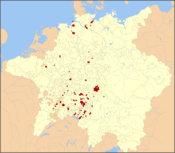
Free Imperial Cities as at 1648 Cities that lost Imperial immediacy or gained independence before 1792 BaselS · BernS · Besançon · Brakel · Cambrai · Diessenhofen · Donauwörth · Duisburg · Düren · Gelnhausen · HagenauD · Herford · KaysersbergD · KolmarD · Konstanz · LandauD · Lemgo · LucerneS · Mainz · Metz · MunsterD · ObernaiD · Pfeddersheim · Rheinfelden · RosheimD · St. GallenS · Sarrebourg · SchaffhausenS · Schmalkalden · SchlettstadtD · SoestH · SolothurnS · Straßburg · Toul · TurckheimD · Verden · Verdun · Warburg · Weißenburg in ElsaßD · ZürichSD: Member of the Décapole. H: Member of the Hanseatic League. S: Member or associate of the Swiss Confederacy. A history of empires Ancient empires Medieval empires Byzantine · Hunnic · Arab (Rashidun · Umayyad · Abbasid · Fatimid · Caliphate of Córdoba · Ayyubid) · Moroccan (Idrisid · Almoravid · Almohad · Marinid) · Persian (Tahirid · Samanid · Buyid · Sallarid · Ziyarid) · Ghaznavid · Bulgarian (First · Second) · Benin · Great Seljuq · Oyo · Bornu · Khwarezmian · Aragonese · Timurid · Indian (Chola · Gurjara-Pratihara · Pala · Eastern Ganga dynasty · Delhi) · Mongol (Yuan · Golden Horde · Chagatai Khanate · Ilkhanate) · Kanem · Serbian · Songhai · Khmer · Carolingian · Holy Roman · Angevin · Mali · Chinese (Sui · Tang · Song · Yuan) · Wagadou · Aztec · Inca · Srivijaya · Majapahit · Ethiopian (Zagwe · Solomonic) · Somali (Ajuuraan · Warsangali) · AdaliteModern empires Tongan · Indian (Maratha · Sikh · Mughal) · Chinese (Ming · Qing) · Ottoman · Persian (Safavid · Afsharid · Zand · Qajar · Pahlavi) · Moroccan (Saadi · Alaouite) · Ethiopian · Somali (Dervish · Gobroon · Hobyo) · French (First · Second) · Austrian (Austro-Hungarian) · German · Russian · Swedish · Mexican (First · Second) · Brazil · Korea · Japan · Haitian (First · Second) · Central AfricanColonial empires German Reichs First (Holy Roman Empire), 962-1806 → Second (German Empire), 1871-1918 → Third (Nazi Germany), 1933-1945 → Fourth (hypothetical)Categories:- Former monarchies of Europe
- Former countries in Europe
- Former empires
- States and territories established in 962
- States and territories disestablished in 1806
- Holy Roman Empire
- History of Austria
- History of Germany
- History of the Netherlands
- House of Habsburg
- Former theocracies
- Christian terms
Wikimedia Foundation. 2010.



